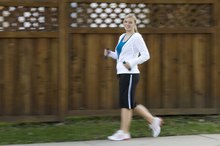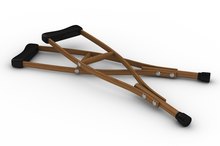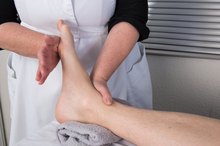A Pulled or Stretched Achilles Tendon
The Achilles tendon connects your calf muscles to the biggest bone in your foot, enabling you to walk, run and adjust your footing according to the surface you are on. A pulled or stretched Achilles tendon can cause problems throughout your legs and spine as your body compensates for a dysfunctional lower leg. Such changes can result in pain around your neck, lower back, hips and knees. Protect your Achilles tendon by doing calf stretching and strengthening exercises.
Prevention
Incorporating resistance training, stretching and jumping exercises into your weekly exercise routine can help prevent Achilles tendon strains. Performing dumbbell calf raises with the ball of your feet at the edge of a step for three to four sets of six to 12 repetitions using moderate to heavy weights will strengthen your Achilles tendon. Including jumping jacks or squat jumps enhances the ability of your tendon to quickly stretch then quickly contract, preparing your tendon to respond to the everyday forces exerted on your ankles. Finally, you should always stretch your calves and ankles at the end of your leg workout and your aerobic exercises, enhancing the tendon’s flexibility to reduce risk of injury.
- Incorporating resistance training, stretching and jumping exercises into your weekly exercise routine can help prevent Achilles tendon strains.
- Performing dumbbell calf raises with the ball of your feet at the edge of a step for three to four sets of six to 12 repetitions using moderate to heavy weights will strengthen your Achilles tendon.
Initial Treatment
Workouts for Tendonitis Leg Pain
Learn More
Immediately after you pull or stretch your Achilles tendon, you should stop what you are doing. Applying an ice pack over the tendon will reduce swelling, pain and inflammation, decreasing the impact of the injury on the surrounding healthy tissues. Use the ice pack for 10 minutes three times a day for the next two days. Then, use a hot pack on your injury for 10 minutes three times a day for two days. If your ankle really hurts, consider taking a non-steroidal anti-inflammatory drug such as aspirin to further reduce pain and swelling. Rest your ankle as much as possible by minimizing the amount of time you spend standing or walking on it. Should your tendon continue to hurt, check with a physical therapist for advanced care.
- Immediately after you pull or stretch your Achilles tendon, you should stop what you are doing.
- Should your tendon continue to hurt, check with a physical therapist for advanced care.
Stretching
Once pain and inflammation have been substantially reduced, range of motion exercises should be implemented. If you are seeing a physical therapist, you should do your stretches under the guidance of your therapist. Apply a heat pack to your injured Achilles tendon for 10 minutes prior to stretching, enhancing circulation and reducing pain during your stretches. Stretch the affected ankle slowly, using your healthy leg and your arms to adjust the amount of body weight you apply to the stretch. Ankle stretches are held for four repetitions of 15 to 30 seconds.
- Once pain and inflammation have been substantially reduced, range of motion exercises should be implemented.
- Apply a heat pack to your injured Achilles tendon for 10 minutes prior to stretching, enhancing circulation and reducing pain during your stretches.
Strengthening
Shin Stretches for Runners
Learn More
The Achilles tendon is indirectly strengthened when you do squats, lunges and deadlifts. Calf raises, however apply the greatest amount of force against your calf muscles, directly strengthening your Achilles tendon. This exercise may be done standing on the edge of a big weight plate, step or on a calf machine. First, start with just your body weight and work both calves at the same time. Then, work one calf at a time, using progressively heavier dumbbells. Alternate the direction in which you point your toes for each set to vary the direction of the force, strengthening your recovering Achilles tendon.
- The Achilles tendon is indirectly strengthened when you do squats, lunges and deadlifts.
- Calf raises, however apply the greatest amount of force against your calf muscles, directly strengthening your Achilles tendon.
Related Articles
References
- “Examination of Musculoskeletal Injuries”; Sandra Shultz, Ph.D., Peggy Houglum, Ph.D., and David Perrin, Ph.D.; 2005
- “Therapeutic Exercise for Musculoskeletal Injuries”; Peggy Houglum, Ph.D.; 2005
- Maughan KL, Boggess BR. (2018). Achilles tendinopathy and tendon rupture. Fields KB, ed. UpToDate. Waltham, MA: UpToDate Inc.
- Lopez RG, Jung HG. Achilles tendinosis: treatment options. Clin Orthop Surg. 2015;7(1):1-7. doi:10.4055/cios.2015.7.1.1
- Medina Pabón MA, Naqvi U. Achilles Tendonitis. Treasure Island (FL): StatPearls Publishing. Updated April 8, 2019.
- Tu P. Heel Pain: Diagnosis and Management. Am Fam Physician. 2018;97(2):86-93.
- Fakoya AOJ, Otohinoyi DA, Fakoya FA. Correlation of some predisposing intrinsic conditions with the morphological integrity of the Achilles tendon. Ann Afr Med. 2018;17(2):58-63. doi:10.4103/aam.aam_49_17
- Bass E. Tendinopathy: Why the Difference Between Tendinitis and Tendinosis Matters. Int J Ther Massage Bodywork. 2012;5(1):14-17.
- Gulati V, Jaggard M, Al-nammari SS, et al. Management of achilles tendon injury: A current concepts systematic review. World J Orthop. 2015;6(4):380-6. doi:10.5312/wjo.v6.i4.380
- Vyas S, Bhalla AS, Ranjan P, Kumar S, Kumar U, Gupta AK. Rheumatoid Arthritis Revisited - Advanced Imaging Review. Pol J Radiol. 2016;81:629-635. doi:10.12659/PJR.899317
- Kim J, Sung DJ, Lee J. Therapeutic effectiveness of instrument-assisted soft tissue mobilization for soft tissue injury: mechanisms and practical application. J Exerc Rehabil. 2017;13(1):12-22. doi:10.12965/jer.1732824.412
- Park YH, Jeong SM, Choi GW, Kim HJ. How early must an acute Achilles tendon rupture be repaired? Injury. 2017;48(3):776-780. doi:10.1016/j.injury.2017.01.020
- Maughan KL, Boggess BR. (2018). Achilles tendinopathy and tendon rupture. Fields KB, ed. Waltham, MA: UpToDate Inc.
Writer Bio
Paula Quinene is an Expert/Talent, Writer and Content Evaluator for Demand Media, with more than 1,500 articles published primarily in health, fitness and nutrition. She has been an avid weight trainer and runner since 1988. She has worked in the fitness industry since 1990. She graduated with a Bachelor's in exercise science from the University of Oregon and continues to train clients as an ACSM-Certified Health Fitness Specialist.








